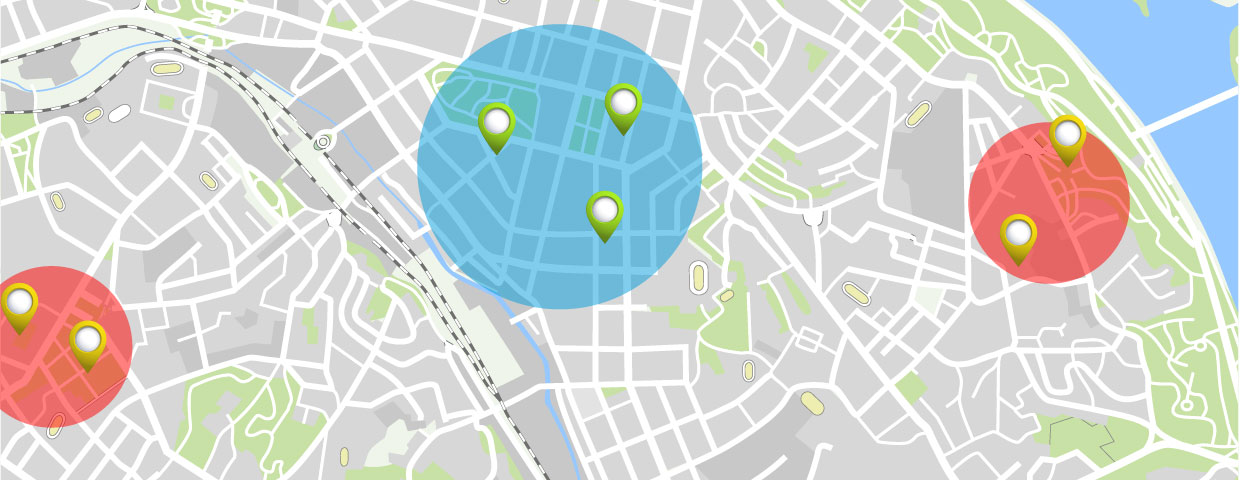The Basics of Geotargeting and Geofencing
Posted by Nikki Wardle on Mar 15, 2018 9:28:00 AM

In the land of digital marketing, we come up with some pretty unique terms. Backlinks, black hat, heatmap, keyword stuffing, schema markup, and slug. These are all jargon, and if you're not in the marketing biz, you probably have no idea what they are referring too.
But no other two terms are probably more misunderstood or confusing than geotargeting and geofencing. I'm here to shed some light on these two popular digital advertising marketing terms.
Geotargeting
Geotargeting is best defined as using a consumer's geographical location to deliver content or advertisements. In the digital marketing world, this is best thought of as paid ads on social media platforms, search engines, or banner ads on certain websites. Geotargeting is often used by businesses to target local or regional customers through paid search campaigns.
Geotargeting can be defined by zip code, city, state, or even as broad as a country.
This method of targeting can be used a couple of ways. Businesses can pay to display their ads to people who are physically located near them, or searching for their product or service in their area.
Geotargeting is by far one of the most popular means used to advertise.
Geofencing
Geofencing is a little more complicated- And by a little, I mean a lot. The simplest definition of geofencing is: targeting a customer or potential customer within a predetermined distance to or around a business or a fixed location using Wifi or Bluetooth for the purpose of sending push notifications to that customer when they enter the geofence.
Huh?
Let's look at how geofencing works to help explain what exactly this practice is all about. To do this, we will talk about Bob. He is a fictional customer of [your brand of choice] and uses the RetailMeNot app to find deals and shop online from time to time, but mostly he shops in their brick and mortar store.
Mentioning the RetailMeNot app is key to this explanation because that app is what is responsible for triggering the push notifications if the user allows GPS to be used and push notifications to be sent. (We will again assume this is 'yes' for both)
Businesses can use geofencing in two ways, first is to engage with the customers (like Bob) when they are close to a physical location. Second is to engage customers when they are close to competitors.
Catching Customers Near Your Business
Bob is downtown getting his shoes shined, which happens to be within the geofence that [your brand of choice] has set within the RetailMeNot app. While Bob is finishing up, he receives a push notification from the app that says they are having a 50% off sale for preferred clients such as him.
Bob is uber excited and heads straight to the store to check out this amazing sale.
Geofencing success at it's best!
Customers close to your competitors
Let's change this story a bit. Bob is on the other side of town from [your brand of choice], near [a competitor brand]. Just as Bob decides to go in and check out [competitor brand], he receives a push notification from [brand of choice] for the same amazing sale of 50% off.
Even though Bob is so close to [competitor brand], a 50% off sale entices Bob to abandon his trip to [competitor brand] and make the trip across town to [brand of choice].
Again, Geofencing success!
The Drawbacks
While I've painted two very positive scenarios of what geofencing can do for your business, there are some drawbacks to consider.
- Just like with any push notifications, you can send too many, and certainly end up sending notifications that are not relevant to the users. You need to develop a good strategy when using geofencing so that you don't end up driving away potential customers.
- Having an app that uses GPS is extremely draining on mobile batteries, even when the app is only running in the background. There are a few different levels of how GPS can be used that does help save battery life, but they are less accurate with a user's physical location.
Geotargeting AND Geofencing
Geotargeting is by far the easiest and least expensive of the two to implement and use to target your potential and current customers. It's used in the most popular search engine advertising models and certainly used in all of the major social media advertising. If you're doing any paid advertising one any of those platforms, it's worth reviewing your location targeting settings.
As for Geofencing, while there is so much more involved to geofence your customers, the opportunities for payoffs are far greater. It can make a big impact on customer engagement and returning shoppers.
I hope I have been able to shed some light on geotargeting and geofencing. Now go forth and market wisely.
Written by Nikki Wardle
Nikki has a degree in Marketing from Boise State University and worked as an Inbound Marketing Specialist at Tribute Media from 2014 to 2019. She's a Google Whiz and dog lover, now serving as a marketing director for a local veterinary clinic.



